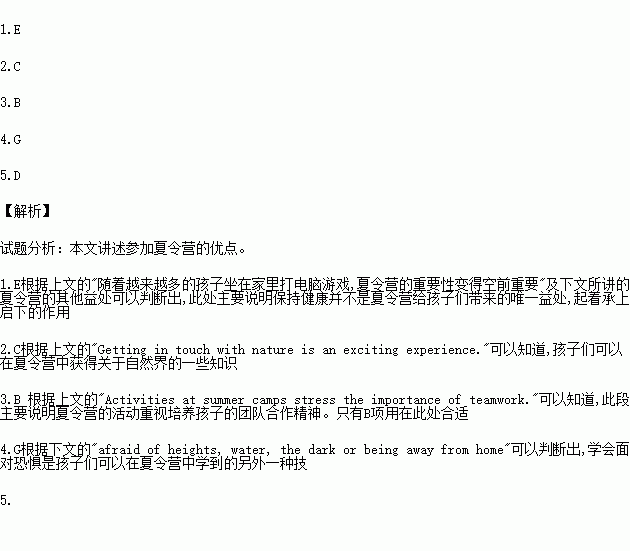题目内容
根据短文内容,从短文后的选项中选出能填入空白处的最佳选项。选项中有两项为多余选项。(E=AB, F=AC, G=AD)
Benefits of summer camps for kids
Summer camps are great for children of all ages. If you go to a summer camp as a child, you are likely to have good memories of things you did and people you met. With more and more children sitting inside playing computer games, the importance of camps has never been greater. ___1.___
Getting in touch with nature is an exciting experience. __2.___ They will enjoy the experiences of camping, hiking and exploring in forests, deserts or on the seashore. They can also enjoy the beauty of nature and learn about the importance of environmental protection.
Activities at summer camps stress the importance of teamwork. _3.__ Throughout life, people have to be comfortably operating as part of a team in order to be successful. Summer camps teach kids how to be productive members of a team.
___4.__Whether they are afraid of heights, water, the dark or being away from home, they are encouraged to face them and deal with them in an environment surrounded by supportive people. __5.___ It is also a valuable life lesson that will help them through adulthood.
Summer camps are perfect ways for kids to have fun and develop themselves. So parents should try to find out what interests their kids, and choose the right camp for them.
A. Kids can make friends there.
B. Many activities there are designed to stress it.
C. Kids can learn about the natural world at camps.
D. So kids gain courage and confidence by challenging themselves.
E. In fact, staying healthy is not the only benefit kids can get from it.
F. Learning to live on their own may be an extremely hard lesson for kids.
G. Having the courage to face fears is another skill kids can learn at camps.
 名校课堂系列答案
名校课堂系列答案书面表达
假定你是Song Bo,有一位美国朋友Robot托你在北京找工作。当你看到 《中国日报》(China Daily)上刊登了一则招聘启事的时候,你认为很合适。请你用英文写一封短信(词数100左右),
用E-mail发给Steve,告知此事。广告原文如下:
Foreign Teachers Wanted! The Education Department of the Ladder Information Company Limited is running an English course for children and adults. Requirements: ● Native English speaker ● University degrees in education or related fields preferred ● Foreign expert certification If you are interested, please call us: Tel: 0086-10-68019433 E-mail: liecbj@hotmail.com Beijing Ladder Information Company Limited |
Dear Robot,
________________________________________________________________________________________
________________________________________________________________________________________
________________________________________________________________________________________
________________________________________________________________________________________
________________________________________________________________________________________
________________________________________________________________________________________
Good luck!
Song Bo

